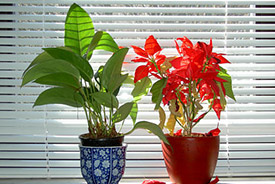Clean your office air with leafy green flair

Office plants (Photo by J. Pilsack, Wikimedia Commons)
On June 8, Canadians will be celebrating Clean Air Day. Part of Canadian Environment Week, Clean Air Day is meant to raise awareness about taking action for cleaner outdoor air. The occasion got me thinking about the quality of indoor air, especially since Canadians spend an average of 90 per cent of our time indoors! I was mostly curious about air quality in offices where many urban Canadians like me spend the better part of our days and adult lives. Should you and I be concerned about what we breathe sitting in our cubicle or corner office?
Bad indoor air can have an impact on our health and our quality of life. According to the Canadian Centre for Occupational Health and Safety, problems with indoor air are generally caused by issues with heating and ventilation systems and through the release of contaminants such as volatile organic compounds. In some cases, people may actually experience sick building syndrome — adverse health effects caused by being exposed to bad air in a building, even for a short amount of time.
Many of us don’t have the option of opening the windows at our office, and replacing a ventilation system is costly, time-consuming and disruptive, particularly in a high-rise. A solution to our office air woes may actually lie in something simple, beautiful and green: household plants!
The filtration power of plants was studied back in the 1980s by NASA. The author of the study, Bill Wolverton, published “How to Grow Fresh Air: 50 Houseplants That Purify Your Home or Office” — a guide intended for the general public. To take full advantage of plant power in your cubicle, it’s best to research which ones will most improve air quality and obtain a variety species to get the job done.
Several websites provide you with lists of the top plants to filter the air of an indoor space (largely recycled from Wolverton’s book). You can find lists here, here and here (PDF). These plants are easy to find, relatively inexpensive, low maintenance and have great names like Xanadu, snake plant and peace lily (soon to be a celebrity’s baby’s name, I wager)!
Spending time in nature can also help reduce the negative impacts of poor indoor air. The trees in our parks, on our streets and in the forests fringing our cities and beyond, help produce oxygen and remove noxious chemicals from the atmosphere.
The Nature Conservancy of Canada (NCC) contributes to cleaner air by protecting and restoring natural spaces that support pollution-scrubbing plant life. NCC lands are accessible and located close to your community, providing a great opportunity to take time for nature, clean your lungs and clear your mind.
As Clean Air Day comes and goes, consider what you can do to reduce air pollution by helping to protect and improve plant life in and around your community. You can also help improve indoor air quality by buying a plant or two for your workspace, or by pooling your resources with colleagues to purchase multiple plants to spread around the office. You could even send this article to your office manager to make the case for an office plant budget! After all, plants have been shown to improve our mood and productivity. They also look good and are much cheaper than man-made air filtration solutions.

